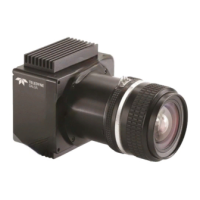59 Piranha 2 User’s Manual
03-032-00493-14 Teledyne DALSA
Appendix A
Camera Link™ Reference
Camera Link is a communication interface for vision applications.
For years, the scientific and industrial digital video market has lacked a standard method
of communication. Both frame grabbers and camera manufacturers developed products
with different connectors, making cable production difficult for manufacturers and very
confusing for consumers. A connectivity standard between digital cameras and frame
grabbers is long overdue and will become even more necessary as data rates continue to
increase.
Increasingly diverse cameras and advanced signal and data transmissions have made a
connectivity standard like Camera Link a necessity. The Camera Link interface will
reduce support time, as well as the cost of that support. The standard cable will be able to
handle the increased signal speeds, and the cable assembly will allow customers to
reduce their costs through volume pricing.
LVDS Technical Description
Low Voltage Differential Signaling (LVDS) is a high-speed, low-power general purpose
interface standard. The standard, known as ANSI/ TIA/ EIA-644, was approved in March
1996. LVDS uses differential signaling, with a nominal signal swing of 350mV differential.
The low signal swing decreases rise and fall times to achieve a theoretical maximum
transmission rate of 1.923 Gbps into a loss-less medium. The low signal swing also means
that the standard is not dependent on a particular supply voltage. LVDS uses current-
mode drivers, which limit power consumption. The differential signals are immune to ±1
V common volt noise.
Camera Signal Requirements
This section provides definitions for the signals used in the Camera Link interface. The
standard Camera Link cable provides camera control signals, serial communication, and
video data.
Video Data
The Channel Link technology is integral to the transmission of video data. Image data
and image enable signals are transmitted on the Channel Link bus. Four enable signals
are defined as:
• FVAL—Frame Valid (FVAL) is defined HIGH for valid lines.
• LVAL—Line Valid (LVAL) is defined HIGH for valid pixels.
• DVAL—Data Valid (DVAL) is defined HIGH when data is valid.
• Spare— A spare has been defined for future use.
All four enable signals must be provided by the camera on each Channel Link chip. All
unused data bits must be tied to a known value by the camera. For more information on

